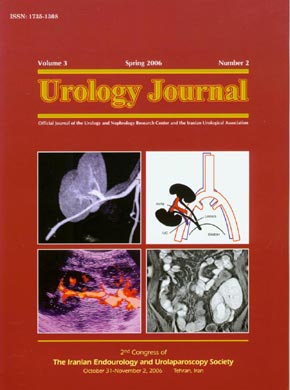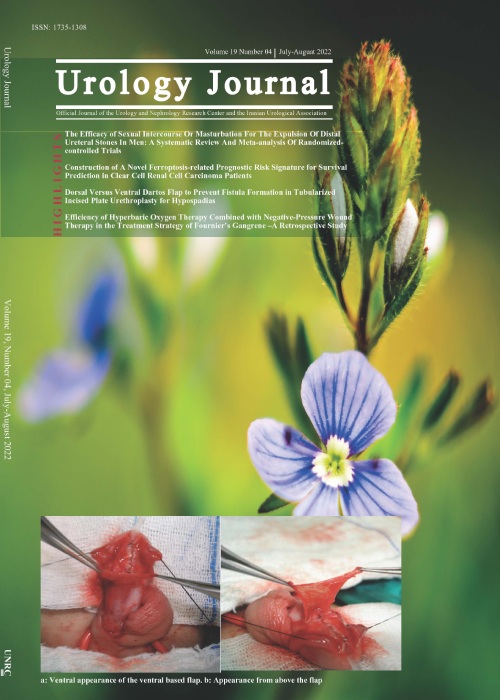فهرست مطالب

Urology Journal
Volume:3 Issue: 2, Spring 2006
- 56 صفحه،
- تاریخ انتشار: 1385/05/05
- تعداد عناوین: 10
-
-
Page 71IntroductionAdrenal myelolipomas are benign lesions that contain hematopoietic and fatty elements. They are usually hormonally inactive and asymptomatic until they reach large sizes. With the routine use of cross-sectional imaging, these lesions are now being discovered with increasing frequency.Materials And MethodsWe performed a comprehensive review of the literature using the PubMed database containing the key word adrenal myelolipoma.ResultsWe identified 492 articles written from 1956 to 2006 and reviewed 93 in detail including the authors’ own experience. In this review, we highlighted the salient diagnostic features of adrenal myelolipomas and offered a guide for management of these benign lesions.ConclusionAdrenal myelolipomas may grow over time, but they can usually be followed without surgical excision. In some cases, very large myelolipomas can present with pain and can be confused with necrotic adrenal carcinomas, thus necessitating their surgical removal.
-
Endourology and Stone Diseases / Extracorporeal Shock Wave Lithotripsy and Transureteral Lithotripsy in the Treatment of Impacted Lower Ureteral CalculiPage 75IntroductionWe compared the efficacy of extracorporeal shock wave lithotripsy (SWL) with ureteroscopy followed by transureteral lithotripsy (TUL) for the treatment of impacted distal ureteral calculi.Materials And MethodsA total of 96 patients with solitary impacted distal ureteral calculi were assigned into 2 groups of treatment with SWL (42 patients) and TUL (54 patients) with a 6.9-F semirigid ureteroscope. Characteristics of the patients and the calculi, treatment parameters, clinical outcomes, and patients’ satisfaction were assessed for each group as well as efficiency quotient.ResultsDemographic characteristics of the patients in the 2 groups were similar as well as the sizes of the calculi. The stone-free rate, 2 months postoperatively, was 71.4% in the patients of the SWL group and 88.9% in those of the TUL group. The efficiency quotient was 56% and 81% for the SWL and TUL groups, respectively (P =. 004). Retreatment rate was 26.2% (11 patients) and 9.3% (5 patients) for the SWL and TUL groups, respectively (P =. 027). Thirty patients in the SWL group (71.4%) and 52 in the TUL group (96.3%) were satisfied with their treatment (P =. 001). There were no major complications in neither of the groups. Minor complications (pain and hematuria) were more common in the TUL group.ConclusionBased on the results of this study, TUL seems to be more effective than SWL in the treatment of impacted lower ureteral calculi sized smaller than 12 mm, and patients are more satisfied with this treatment method.
-
Urological Oncology / Relationship Between Expression of P53 Protein and Tumor Subtype and Grade in Renal Cell CarcinomaPage 79IntroductionOur aim was to evaluate the overexpression of p53 protein, product of mutated TP53 gene, in histologic sections of the kidneys with renal cell carcinoma (RCC) and its association with tumor grade and subtype.Materials And MethodsA total of 66 histologic sections of the kidneys of patients with the diagnosis of RCC were re-evaluated and tumor grade, tumor subtype, and p53 expression were determined.ResultsOf the total 66 histologic sections with the diagnosis of RCC, 34 (51.5%), 27 (41%), and 5 (7.5%) were conventional, papillary, and chromophobe subtypes, respectively. Fifty-one (77.3%), 14 (21.2%), and 1 (1.5%) of tumors were grade 2, 3, and 4, respectively. Thirty (45.4%) sections were positive for p53 immunohistochemical staining. In 7 cases (20.6%) of the conventional tumors, p53 staining was positive, while 18 papillary (66.6%) and 5 chromophobe tumors (100%) had a positive staining for p53 (P <. 001). Seventeen out of 51 grade 2 tumors (33.4%) and 12 out of 14 grade 3 tumors (85.7%) were positive for p53. The single case of grade 4 tumor was positive for p53 protein, too (P =. 001).ConclusionIncreased expression of p53 protein is rather prevalent in RCC. This factor is associated with tumor grade and subtype. According to our findings, it is generally accompanied by nonconventional subtypes and higher tumor grades.
-
Kidney Transplantation / En Bloc Kidney Transplantation from Pediatric Cadaveric Donors to Adult RecipientsPage 82IntroductionThe shortage of cadaveric donors for kidney transplantation has led to the expansion of the criteria used for donor selection, such as the use of pediatric cadaveric donors. In this study we reviewed our results of en bloc kidney transplantation of pediatric cadaveric donors to adults.Materials And MethodsFrom May 2001 to May 2005, 245 cadaveric kidney transplants have been performed in our hospitals. Seven of these were en bloc kidney transplantations in adult recipients from marginal pediatric donors (age < 5 years, donor weight < 15 kg, high creatinine clearance, or kidney length < 8 cm). We reviewed their records. Follow-up (range, 3 to 24 months) included ultrasonography, dimercaptosuccinic acid renal scintigraphy, and magnetic resonance imaging.ResultsSerum levels of creatinine ranged between 0.8 m/dL to 1.9 mg/dL during the follow-up period. One patient died of myocardial infarction 3 months postoperatively. One-year graft and patient survivals were both 85.7%. Complications included acute tubular necrosis in 1 patient (managed by conservative therapy and dialysis for 2 weeks), renal vein thrombosis in 1 (treated by anticoagulation), and subcutaneous hematoma in 1. There were no urologic complications. Median size of the grafts was 7.2 cm preoperatively that reached 9.6 cm, 3 months postoperatively (P =. 018). Twelve months following operation, the median size of the grafts reached 11 cm (P =. 045).ConclusionEn bloc pediatric kidney transplantation is a safe and suitable alternative for adult recipients. One-year graft and patient survivals are acceptable and complication rate is low.
-
Sexual Dysfunction and Infertility / Prevalence of infertility in Tabriz in 2004Page 87IntroductionOur aim was to determine the prevalence of primary and secondary infertility in Tabriz population and to compare the marriage age between infertile and fertile groups. We also evaluated the rate of seeking help for treatment of infertility among the patients.Materials And MethodsIn a survey, we evaluated the prevalence of infertility in Tabriz in 2004 using cluster random sampling. Tabriz was divided into 360 zones and from each zone, 10 couples were selected. Six interviewers filled out the questionnaires by direct reference to interviewees’ homes. Overall, 3600 couples were evaluated for infertility.ResultsOf 3600 couples, 3183 were married for more than a year and answered the questions appropriately. Prevalence of infertility was 3.27% (2.04% as primary and 1.23% as secondary infertility). Among couples whose wives were in their reproductive age (15 to 49 years), the overall prevalence of infertility was 3.35% (2.05% as primary and 1.30% as secondary). Mean age of women at marriage was significantly higher in couples with primary infertility (20.87 ± 5.4 versus 18.75 ± 4.04; P <. 001). Treatment seeking was 79.6% and 67.6% among patients with primary and secondary infertility, respectively. In general, 75% of the patients had referred to medical centers.ConclusionThe prevalence of primary infertility was almost the same as other Asian countries, but the prevalence of secondary infertility was lower than other countries. A higher marriage age was accompanied with a significant decrease in fertility of the couple. Primary infertile patients had referred to medical center slightly more often than secondary infertile patients.
-
Page 92IntroductionOur aim was to evaluate the predictive values of factors that indicate successful sperm retrieval in men with nonobstructive azoospermia.Materials And MethodsWe evaluated 85 infertile men with nonobstructive azoospermia who underwent multiple bilateral testicular biopsies. Factors including age, infertility period, surgical history, testicular volume, testicular consistency, serum follicle-stimulating hormone (FSH), serum inhibin B, serum luteinizing hormone, and serum total testosterone were assessed in relation to sperm retrieval results.ResultsSpermatozoa were retrieved in 18 biopsies (21.2%). Follicle-stimulating hormone, serum inhibin B, and testicular volume were associated with the results of sperm retrieval. Men with a higher testicular volume, a higher serum inhibin B, and a lower FSH had successful sperm retrieval. The cutoff points were determined as 9.5 mL for testicular volume, 9.9 IU/L for serum FSH, and 39.8 pg/mL for serum inhibin B. These 3 factors had strong correlations with each other. The sensitivities and specificities were 88.9% and 94% for testicular volume, 97% and 83.3% for FSH, and 72.2% and 95.5% for serum inhibin B, respectively. The positive predictive value for a combination of serum FSH and inhibin B was 100%.ConclusionSerum FSH and serum inhibin B are useful markers for evaluation of the presence of sperm in patients with nonobstructive azoospermia. Inhibin B has a high specificity when combined with serum FSH and their measurements can be helpful in all patients with nonobstructive azoospermia before decision making for sperm retrieval.
-
Page 97IntroductionL,L-ethylenedicysteine (EC) is a new carrier of technetium Tc 99m (99mTc) with a lower affinity to plasma albumin in comparison with diethylenetriamine pentaacetic acid (DTPA). We compared 99mTc-EC scan with 99mTc-DTPA scan in diuretic renography for patients with obstructive uropathy.Materials And MethodsThirty-three patients with upper urinary tract obstruction were randomly selected and underwent diuretic renographies by 99mTc-EC and 99mTc-DTPA. The counts of radioisotope per pixel in the target (the kidney) and background tissues as well as the clearance half-life of these two radiopharmaceuticals were measured and compared.ResultsMean counts of radioisotope per pixel in the target tissue was not different between 99mTc-EC and 99mTc-DTPA scans, but in the background tissue, it was less for 99mTc-EC (P =. 003). Target-background ratio was higher for 99mTc-EC scan (3.80 ± 2.11 versus 2.48 ± 1.39; P <. 001). Renal clearance half-life of radioisotope was shorter for 99mTc-EC scan than 99mTc-DTPA scan (58.15 ± 15.17 minutes versus 78.65 ± 19.99 minutes; P =. 033). The results were similar for uremic patients (with a serum creatinine level > 2mg/dL).ConclusionTarget-background ratio of radiopharmaceutical uptake rates in diuretic renography was a good indicator of the higher resolution of 99mTc-EC than 99mTc-DTPA scan. We also demonstrated the faster clearance of 99mTc-EC than 99mTc-DTPA. This results in less radiation that is especially useful in children. To our opinion, 99mTc-EC can better depict the kidneys in comparison with 99mTc-DTPA.
-
Page 104IntroductionOur aim was to investigate the diagnostic efficacy of C-reactive protein (CRP) and erythrocyte sedimentation rate (ESR) in patients with acute scrotum.Materials And MethodsOne hundred and twenty patients with an acute scrotum were evaluated and assigned into 3 groups: 46 had acute epididymitis (group 1), 23 had spermatic cord torsion (group 2), and 51 had other noninflammatory causes of acute scrotum. Serum samples of all patients taken at the time of admission were tested for CRP levels and ESR.ResultsAn at least 4-fold increase in the serum CRP levels was seen in 44 patients (95.6%) in group 1 (mean, 67.77 ± 47.80 mg/L). In contrast, only 1 patient in group 2 had a significant increase in serum CRP level (mean, 9.0 ± 4.90 mg/L). The patients in group 3 did not experience any significant increase of CRP levels (mean, 7.0 ± 2.2 mg/L). The patients with epididymitis had higher CRP and ESR values than others (P <.001; P <.001). The best cutoffs were 24 mg/L for CRP and 15.5 mm/h for ESR to differentiate between epididymitis and noninflammatory causes of acute scrotum. The sensitivity and specificity were 93.4% and 100% for CRP and 95.6% and 85.1% for ESR, respectively.ConclusionBased on our findings, serum levels of CRP and ESR can provide helpful information easily and rapidly for differentiation between epididymitis and other causes of acute scrotum. We suggest CRP and ESR be measured before making a decision of surgical exploration.
-
African Journal of UrologyPage 110


